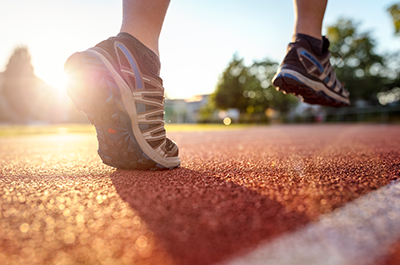If you’re a runner, there’s a good chance you’ve had at least one bout of runner’s gut (also known as runner’s stomach). Maybe it was during a training run. Or worse yet, during an important race. Suddenly, your stomach starts cramping and you’re frantically searching for the nearest porta-potty.
“Symptoms of runner’s gut can occur in up to 90% of long-distance runners,” says Stefanie Heyser, PT, DPT, ATC, a physical therapist and running coach at Henry Ford Health. “And it’s not unusual for runners to experience some type of stomach issues, whether they’re training for a marathon or a 5K.”
With a little careful planning and strategies, you can keep your stomach healthy while you run.
Common Symptoms of Runner’s Gut
Stomach problems related to running typically occur during—or soon after—a run. Common gastrointestinal (GI) symptoms runners experience include:
- Abdominal pain
- Cramping
- Diarrhea
- Nausea or vomiting
For most runners, symptoms don’t become serious. But they can easily wreck your run and get in the way of crossing the finish line.
Possible Causes of Runner’s Gut
Symptoms of runner’s gut occur more often during longer endurance events. Athletes running a marathon (or longer distance) may be more likely to experience stomach issues than those doing a 5K.
“These symptoms are really common, but what triggers them can vary from person to person,” says Heyser.
The longer you’re exercising and stressing your body, the more likely you are to deal with some GI upset. Some possible reasons why many runners experience stomach issues include:
- Dehydration
- Environmental factors, such as extreme heat or altitude
- Foods that are difficult to digest or upset the stomach
- Nerves before a race
- Reduced blood flow to the gut during exercise
Practice What to Eat During a Run
Diet can’t necessarily fix or prevent all symptoms of runner’s stomach, but the right fuel can help. “Just as you train your body in preparation for a race, you can also train your gut,” says Heyser. “The gut can be adaptable and it can learn to tolerate more food and hydration during exercise.”
That means practicing your nutrition and finding out what works—and what doesn’t. Each person’s digestive system is unique, so finding the right types and amounts of food will require some trial and error. That said, there are some guidelines that can help you fuel your body appropriately during your runs.
“The biggest mistake runners make is to underfuel,” says Heyser. For example, many runners opt for a gel once an hour, but most provide less than 30 grams of carbohydrate. Carbohydrates are what your body uses for energy. Not getting enough during and after exercise can also get in the way of your recovery.
“The recommendation is to fuel with 30 to 60 grams of carbohydrate for every hour of exercise and there is research to support even 90 grams per hour or more especially for longer events,” she says. But if you haven’t been fueling with that much, you should start with a lower amount and build up gradually.
Gels, chews and liquid nutrition are the most popular sources of fuel for runners for good reason. They deliver mostly simple carbohydrates that are easy to digest and provide almost-instant energy. “Before and during a run or race you want to avoid high-fiber foods that can have a negative effect on your digestive system,” says Heyser.
The Importance of Staying Hydrated
Hydration is an often-overlooked issue for runners. Maybe you don’t want to carry fluids with you or maybe you feel like drinking makes your stomach issues worse.
“It’s especially important to take in enough fluid when your body is trying to digest high-carb foods like gels and chews,” says Heyser. “They’re very concentrated forms of carbohydrate, and you need to drink enough with them to avoid issues.”
She recommends taking in at least 16 to 24 ounces of fluids per hour. But plain water isn’t always best. “You can run into trouble if you hydrate without also replacing electrolytes, like sodium,” she says. This is especially true on hot days and races where you may be on the course for several hours.

Go Where The Pros Go
Nothing New on Race Day
Determining the best nutrition and hydration options is a critical part of your training plan. “You don’t want to wait till the end of your training to figure out your plan for fueling your body on race day,” says Heyser. “And you certainly don’t want to try anything new at the last minute.”
If you’re doing a race, be prepared to carry your tried-and-true options with you. This isn’t the time to try whatever they’re handing out at the aid stations unless you know how it will affect your stomach. You can also find out in advance what the aid stations will serve and try it during training runs.
“There’s also a push now—especially in longer races—to eat ‘real’ food instead of gels and chews,” says Heyser. It’s not uncommon to see foods like baked potatoes, chips, trail mix, peanut butter and jelly sandwiches or even candy in the aid tents at ultramarathons.
The advantage of mixing in some real food is that it helps avoid palate fatigue, says Heyser. If you’re running for several hours, you might appreciate a break from downing a gel or handful of chews every 30 minutes. Your body may also need some real food during longer events, since you’re missing entire meals during the race duration.
The downside is that these foods may be higher in fiber or fat, which is more difficult to digest on the run. “They might not be well-tolerated, so it’s important not to find that out by eating them for the first time during your race,” says Heyser.
When to See Your Doctor About Runner’s Gut
Most runners figure out their own best strategies for reducing or preventing runner’s gut symptoms. But if stomach troubles continue—no matter what you do or don’t eat during a run - it may be time to see your doctor.
Persistent stomach issues can be a sign of other digestive conditions. Your doctor can determine if you need to see a gastrointestinal (GI) specialist for testing for irritable bowel syndrome, colitis or other GI concerns.
Reviewed by Stefanie Heyser, PT, DPT, ATC, a physical therapist at the Henry Ford Center for Athletic Medicine.



